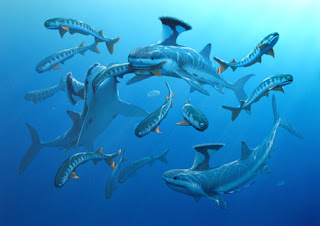Neanderthals in the news again, this time with a story about some tools found in roadworks in Kent. On the face of it, the
story itself is an interesting one, with the sediments containing the finds being dated at between 100 and 110 thousand years ago. Significant because Britain is generally thought to have been empty of people - Neanderthal and
Homo sapiens - at the time. This was at the start of the last Ice Age and around 40,000 years before the island was supposedly inhabited by hominids again. It's known Neanderthals were nearby in Northern France at this time, and to me it seems unlikely there weren't a few making it over the relatively short stretch of water and ice. Sea levels were fluctuating considerably and there were at least patches of land in what's now the Channel at time between 100,000 and 60,000 years ago. They weren't known as seafarers, but the lure of all those tasty mammoth would have been a powerful draw.
The point I'd like to take up, though, is the reservations of others in the scientific community about the
accuracy of the dating technique used by the research team. Given that the point of the story here is that the dating of the finds puts Neanderthals in Britain well before it had been thought they'd arrived - it all falls down if the technique used is not scientifically robust. In this case, the team from the University of Southampton and Oxford Archaeology used
Optically Stimulated Luminescence (OSL) which measures the length of time since some minerals were exposed to daylight. It can be a useful and reliable dating tool within certain parameters. Some have pointed out that these dates are at - or exceed - the limits of time range of OSL's effective application, which may throw a little doubt over the results obtained.
I have a bit of a personal issue with this topic. Proponents of Young Earth Creationism are keen to attack geological and archaeological dating techniques, and I get to meet a few of them - only now and again - in the shop. It's usually an interesting experience, and usually frustrating. Without wishing to tar them all with the same brush, typically they have the idea that there is a large body of scientists that doubt the efficacy of dating techniques. This is not the case. There are, of course, scientists out there with these beliefs, but they are a tiny minority. Young Earthers seem to think that if they can discredit carbon dating - almost always the only method they have heard about - all of natural science will collapse and people will turn to religion. Presumably theirs.
There are a number of tried and tested approaches used to determine the age of rocks or sediments which produce repeatable results and can very often be cross-checked with more than one technique. Their reliability is not in any doubt when used correctly. So - where a dating method is used with surprising results or in potentially ineffective circumstances it is vital that the evidence and outcomes are examined more critically than ever. The scientific process relies on impartial observation and careful peer review. It's worth being as sure as you can be, and worth admitting when you aren't.

fo.jpg)
